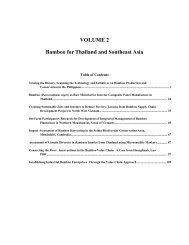WBC-VIII-Vol.4 – Resources – Forestry, Plantations and ... - BambuSC
WBC-VIII-Vol.4 – Resources – Forestry, Plantations and ... - BambuSC
WBC-VIII-Vol.4 – Resources – Forestry, Plantations and ... - BambuSC
You also want an ePaper? Increase the reach of your titles
YUMPU automatically turns print PDFs into web optimized ePapers that Google loves.
Background: KEFRI Trial <strong>Plantations</strong><br />
In 1988 the Kenya Forest Research Institute (KEFRI), through the initiative of Dr. Bernard Kigomo, started a<br />
bamboo research program that involved the establishment of trial plantations of exotic bamboo species in six<br />
locations within three regions of Kenya. The 6 trial plantations sites of KEFRI are located in (i) Kakamega <strong>and</strong><br />
(ii) Siaya in the Lake Region, (iii) Muguga <strong>and</strong> (iv) Penon in the Highl<strong>and</strong>s, <strong>and</strong> (v) Gede <strong>and</strong> (iv) Jilore in the<br />
coastal region.<br />
Some of the bamboo planting materials that were used in the trials were obtained in Kenya but most of the<br />
germplasm was imported from Rw<strong>and</strong>a, Tanzania, Zimbabwe, India, Thail<strong>and</strong>, <strong>and</strong> Japan in the form of seeds<br />
<strong>and</strong> vegetative material. The germplasm was mass propagated at the KEFRI nursery in Muguga <strong>and</strong><br />
subsequently planted in the trial sites between 1988 <strong>and</strong> 1990.<br />
An initial study of the trials was made by KEFRI in 1995 <strong>and</strong> published by Dr. B. N. Kigomo <strong>and</strong><br />
Mr. G. O. Sigu (1996). Their study provides details of the characteristics of the planting sites, the form (i.e.,<br />
seeds, rhizomes, offsets, or cuttings) <strong>and</strong> provenance of the germplasm, the species planted in each site, as well<br />
as success or failure, <strong>and</strong> growth performance of each species per site.<br />
Objectives <strong>and</strong> Expected Results of the Plantation Analyses<br />
The objective of studying the KEFRI trial plantations was to analyze the trial plantations in various regions<br />
Kenya in order to provide up to date information on species to site matching, with specific focus on identifying<br />
suitable species for developing bamboo plantations in the Lake Region, Highl<strong>and</strong>s <strong>and</strong> coastal regions of Kenya.<br />
Due to time limitations <strong>and</strong> logistical constraints, only 4 out of the 6 KEFRI trials sites were studied, namely:<br />
Kakamega, Muguga, Gede <strong>and</strong> Jilore.<br />
Since the trial sites at Siaya in the Lake Region <strong>and</strong> Penon in the Highl<strong>and</strong>s were not visited, it was therefore not<br />
possible to analyze <strong>and</strong> compare the results of the trials plots in Penon to those of Muguga, nor to compare the<br />
results of the Kakamega trials to those of Siaya.<br />
The characteristics of these sites included in this study are shown in Table 1.<br />
Table 1: Characteristics of KEFRI Bamboo Trial Sites<br />
Site KAKAMEGA MUGUGA GEDE JILORE<br />
Region Lake Region Highl<strong>and</strong>s Coastal (Malindi) Coastal (Malindi)<br />
Coordinates 0°14’S / 36°38’E 1°54’S / 34°15’E 3°20’S / 40°5’E 3°12’S / 39°55’E<br />
Altitude 1,675 m asl 2,050 m asl 50 m asl 80 m asl<br />
Temperature (min) 17°C 11°C 22°C 24°C<br />
Temperature (max) 33°C 28°C 33°C 34°C<br />
Annual Rainfall 1100-1950 mm 900-1500 mm 900-1400 mm 550-1000 mm<br />
Soils Dark Brown Loams Deep Dark Red Clay<br />
Loams<br />
Source: Kigomo & Sigu, 1996.<br />
S<strong>and</strong>y White Loams S<strong>and</strong>y-red compact<br />
s<strong>and</strong>y soils<br />
<strong>VIII</strong> World Bamboo Congress Proceedings Vol 4-117




